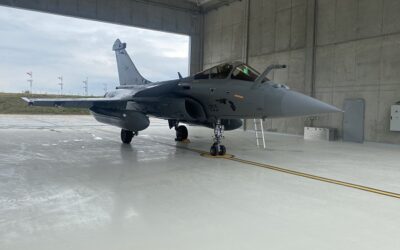Technology upgrades and other programme milestones
Raytheon Missile Systems is at US Navy League Sea-Air-Space Expo at Gaylord National Convention Center, National Harbor, MA, USA, fresh off the contract signing to supply the United Arab Emirates (UAE) with the latest Block 2 version of the RIM-116 Rolling Airframe Missile (RAM) quick-reaction, ship self-defence weapon system, for UAE Naval Forces’ six BAYNUNAH-class corvettes, plus two new Project Arialah offshore patrol vessels (OPV) due for delivery to the UAE Critical Infrastructure and Coastal Protection Authority later this year. Alan Davis, the Director of Raytheon’s Short Range Defense Systems, was asked about the delivery plan for these ship programmes’ missiles and responded: “Unfortunately, delivery schedule for the missiles can’t be discussed.”
RAM Block 2 has been service with the US Navy (USN) since 2015. Further, Germany and Japan have also ordered the Block 2 missile and have received on time deliveries of their respective Block 2 missiles, continuing to expand the international side of the missile portfolio. Davis explained the enhancements which set the Block 2 apart from the baseline RAM missile. “RAM Block 2 technologies represent a substantial improvement in airframe kinematics, control, range, RF discrimination and raid performance. The Block 2 has a new RF receiver that has increased its sensitivity to be able to detect low probability of intercept radars,” he pointed out. “It also has enhanced guidance algorithms that take advantage of the new dual thrust rocket motor. The missile’s improved guidance and navigation system combined with the four steerable canards on the forward end of the missile provides a kinematic upgrade capability enabling RAM Block 2 to out manoeuvre even the most stressing new threat missiles.”
The RAM industry team continues to consist of Raytheon Missile Systems and the RAM-System GmbH consortium of Diehl Defence and MBDA Deutschland GmbH in Germany as prime contractors and co-operating partners. “The RMS/RAMSYS industry team is still in place and continues to manage the 50/50 work share on both the missile and launcher work,” the missile sector expert added.
Asked about the 2017 road map for Block 2 technology upgrades and other programme milestones, Davis replied: “For the most part, RAM has stayed ahead of the threat as we did with Block 2; we looked at what we thought the threats could achieve and provided the overmatch in Block 2. RAM Block 2 is the current production missile and as the threats evolve RAM will also evolve to meet those threats.”
Also in the Raytheon portfolio, Carolyn Beaudry, the media contact for the company’s rapidly evolving AN/SPY-6(V) Air and Missile Defense Radar programme, noted the system’s latest success was the search, acquisition and tracking of a ballistic missile test target during the radar’s first dedicated ballistic missile defence exercise. Heretofore, AN/SPY-6 successfully tracked integrated air and missile defense targets of opportunity, satellites and aircraft. Beudry told the author on the conference floor, “In December 2016 Raytheon was awarded a contract for long-lead materiel for the programme.”
Raytheon further announced a successful tech refresh effort for its venerable PHALANX Close-In Weapon System (CIWS). Tucson, AZ-based programme spokesperson Tara Wood, called Monch’s attention to the recent, successful test of a new electric gun for the system. The upgrade allows soldiers and sailors to fire at varying rates, which uses less ammunition. The goal of the live-fire test was to ensure the electric gun can operate despite the heavy vibrations that occur when PHALANX is fired. The new design replaces a pneumatic motor, compressor and storage tanks, reducing the system’s weight by 180lbs [81.6kg] – an achievement which will resonate with ship program managers who remain concerned with reducing topside weight when feasible. These changes also increase reliability and reduce operating costs.
Marty Kauchak

























